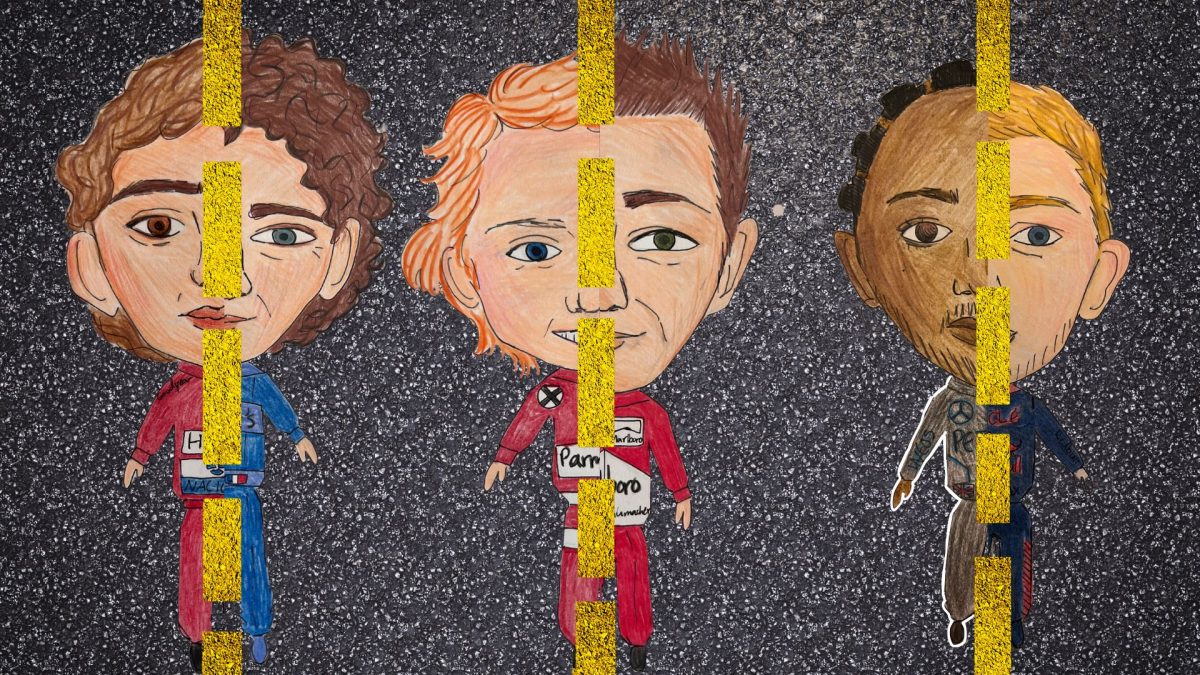If you grew up in the U.S., you may be familiar with NASCAR and the IndyCar Series. Or maybe you watched “Cars” as a kid. Regardless, Formula 1 is another realm within the world of motorsport. At the most basic level, it involves 20 race cars doing laps around oddly shaped tracks at neck-breaking speeds and scathing temperatures. However, Formula 1 is much more beneath its surface.
It is most often referred to as the pinnacle of motorsport — for good reason. It features the brilliant minds of engineers working together with the most talented drivers on the planet. Millions of dollars contribute to the latest racing technology and the overall success of the sport. Constant improvements are being made to cars between races, making for exhilarating competition between drivers.
Formula 1 is extremely competitive, with 10 teams and only two drivers on each. Not only are drivers competing against opposing teams, but they are also competing against their partner on the same team for a chance to be crowned the World Drivers’ Champion at the end of the season. Only the top 10 drivers in each race earn points which are tallied at the end of the season to determine the World Drivers’ Champion. For the Constructors’ Championship, the individual drivers’ points on each team are tallied and added together to determine the team with the most successful car.
The F1 season is longer than the average American sports season. There are 24 races in the 2024 season, beginning in February and ending in December. Races are sprawled across five continents and 21 countries, with three races in Miami, Austin and Las Vegas.
The Rise of Formula 1
“Drive to Survive” first hit the Netflix library in 2019. This six-season docudrama features exclusive interviews with drivers and team principals and behind-the-scenes footage of some of the most significant races in F1 history. With new storylines to follow each season, the drama behind the sport piqued the interest of new American fans.
The show highlighted peak rivalries between teams like Mercedes and Redbull. This historic rivalry introduced Americans to a new young talent, Max Verstappen. Viewers were quickly drawn to Verstappen’s cold, blunt demeanor and the dominance he acquired with so few years in the sport. In a controversial title fight at the 2021 Abu Dhabi Grand Prix, Verstappen passed seven-time World Champion Lewis Hamilton in the last lap of the race and secured his first F1 Championship win.
In a poll conducted by Morning Consultant in March 2022, 53% of 1,900 American adults cited “Drive to Survive” as the reason they took interest in the sport. Additionally, viewership is growing with each new season. In 2023, “Drive to Survive” season five garnered 569,884 viewers in its first week on air, 162,206 more than in 2022.
F1 has been around for decades yet has only had a prominent online presence in recent years. In addition to “Drive to Survive,” social media has allowed drivers to share parts of themselves that are difficult to see on track. Whether through team media or their own account, drivers’ social media presence makes them more relatable and accessible to fans. For instance, Daniel Ricciardo’s naturally humorous personality has made him a loved character on track as well as online. His likeability has practically made him the ambassador for F1 in the U.S. Ricciardo is seen in more American talk shows than any race driver, including Jimmy Kimmel Live, The Late Show with Stephen Colbert and The Ellen Show.
The sport’s official social media accounts serve as the central hub, connecting fans old and new, of different age groups and geographical locations. Posting timely race weekend coverage and emotionally appealing team coverage, the official F1 Instagram account makes information reachable within seconds for new fans. This instant access allows fans to stay informed and engaged in constantly changing conditions. In addition to the official F1 Instagram account, teams also use the platform to post technical updates about car components, fun challenges with drivers, Q&A videos and more to both educate and entertain fans.
F1 is an international sport. For American fans, this makes watching races live challenging. Each race occurs in a different time zone; in the U.S., these times could range from early mornings to late nights. However, despair was not felt for long when the first official American circuit (racetrack) came to fruition. In 2010, Austin, Texas, signed a 10-year contract to host the U.S. Grand Prix from 2012. In 2022, the Miami Grand Prix joined the F1 calendar. Finally, the Las Vegas Grand Prix made its debut in 2023. The most notable race of these, however, is the Miami Grand Prix. In its first year, the race averaged 2.6 million viewers, setting the record for the largest live audience ever for a Formula 1 race on U.S. television. This record was broken in 2024, with 3.1 million Americans watching McLaren’s Lando Norris secure his first Grand Prix win.
Fan Testimonies
Cat Haxton, an ELL teacher at West, wasn’t part of the F1 fandom until 2021. “I didn’t get interested until the 2021 season when there was a really intense battle for the championship between a veteran 7-time world champion, Lewis Hamilton, and a younger driver trying for his first world championship, Max Verstappen,” Haxton wrote. “It was a great rivalry, a very exciting season with some dramatic crashes, and a stunning finale. Since that season, I’ve been hooked and my kids love it too. They have their favorite drivers and love to watch races and make F1 Lego sets with me.”
Venelin Kotev ’26 is an older fan, having watched the sport with his mom since he was younger. Kotev notes watching the 2021 championship with his mom and rooting for Lewis Hamilton at the time. However, he’s grown fond of Verstappen over the years. “I like Max Verstappen at Red Bull. I like Red Bull as a company and the things that they do. And Verstappen himself, he’s got a great personality, and I like his driving style, too,” Kotev said.
Verstappen’s 2021 victory marked a turning point that would affect the sport for years to come. Until and through the 2023 season, Verstappen has dominated just about every race of the year, winning 19 out of 23 races in 2023. This dominance had a negative effect on newer fans especially, causing the sport to lose some of the buzz it once had. “It’s a little boring, to be honest, because Super Max is mostly dominating the field by a wide margin,” Haxton wrote. Yet, Haxton is hopeful that the 2024 season will bring back the excitement. “However, Ferrari looks strong these last few races and there’s still a lot that can happen,” Haxton wrote. “It was great to see Lando Norris win his first F1 race and to see Charles Leclerc win his home race. I’m definitely enjoying this season so far!”
There are only 20 drivers on the F1 grid and essentially only 20 people in the world who can compete in the sport. Getting to this high of a level is not easy and requires preparation starting at an early age. Some see this as one of the sport’s disadvantages. “The worst part is how hard it is for young drivers to get into F1. There are such a limited number of seats and the competition for them is fierce. Some great drivers haven’t been able to make it into the cars or stay in them long,” Haxton wrote.
Another con to the sport is the amount of risk it involves. In the past, crashes happened often and proved to be deadly. “It’s super high risk but overall, I think it’s I think it’s a cool sport to watch. But it’s very demanding on teams and racers themselves,” Kotev said. As time progressed, however, the Fédération Internationale de l’Automobile set regulations to improve driver safety. One of those regulations is the requirement of a curved bar above the driver’s head, the halo. “The sport has become dramatically safer in the last few years, especially with the invention of the halo, and I’d like to see them continue to make it safer for the drivers. It’s a very risky sport and many drivers have died, a fact which casts a shadow over the sport as a whole. I hope they will continue to make it safer for the drivers!” Haxton wrote.
Besides driver-to-driver competition on the field, changing conditions from race to race or year to year adds to the thrill of the sport.
F1 is a unique sport because of its many intricate components. Not only does driver skill matter, but car capabilities do, too. Kotev argues that the latter matters more. “I think it’s really interesting how, although all the drivers are really good, and they’re all skilled, there is still obviously skill differences between the top drivers and the worst driver. But I think what’s more important, actually makes more of a difference in the race, is the car itself,” Kotev said.
Teams invest millions of dollars into improving the performance of their cars. While the FIA sets a cost cap each year, teams can still comfortably spend money earned by winning races and through sponsorships. Well-performing teams earn more money, which can cause financial disparities between teams. Because of this, Kotev suggests that more restrictions on spending could improve the competitive nature of the sport. “One of the biggest aspects of the sport is how much money teams can devote, how much funding they are allowed, but maybe some more restrictive, like spending caps, because some teams like Red Bull or Ferrari, they spend a lot of money and they have that sort of advantage over other teams that don’t have that budget. That’s why Verstappen is so good, because of his car, which they put so much money into,” Kotev said.
2024 marks one of the last years before F1 regulations undergo a significant change. Thus far, it’s also proven to be an unexpected year with team performance and driver pairing shifts. “I’m looking forward to seeing how the teams rise to the challenge that Red Bull and Max Verstappen are presenting to them,” Haxton wrote. “Eventually they will find a way to compete with Red Bull and then things will get really interesting. I’m also really excited to see how Lewis Hamilton fares alongside Charles Leclerc at Ferrari next year, and who will replace Hamilton at Mercedes. Some big changes are coming!”
When asked to give advice to new fans, Haxton wrote, “I would say please don’t be one of those annoying fans that boos or disparages drivers. I see a lot of ugly comments about drivers online and it’s really disgusting how people invest so much negative emotion into hating drivers. I’d say to remember that they’re all human and they all deserve respect for their immense talent and effort.”
F1 is the culmination of a competitive sport and scientific breakthroughs. The hard work behind constructing and constantly improving an F1 car arguably labels the sport as the biggest science experiment in the world. For new fans, F1 is the sport that keeps on delivering, exceeding expectations every time.























